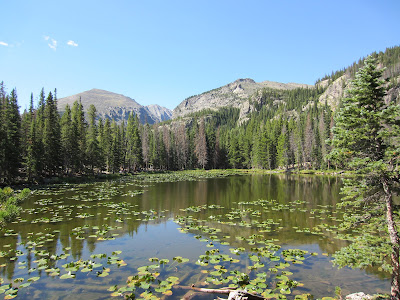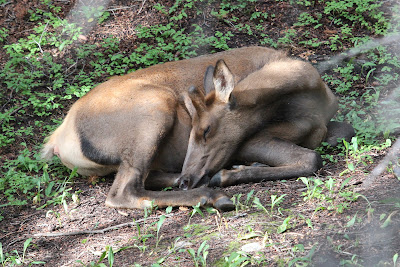The Red Crossbill is another species that Jared was excited to see in Colorado, and we were lucky to see two birds up close for an extended period of time. They seemed oblivious to us as we snapped away on our camera.
As their name suggests, Red Crossbills have a bill that crosses at the tip. They specialize in feeding on conifer cones, particularly spruce species, and the unusual bill shape helps extract the seeds from the cone. Adult males tend to be red or orange in color, and females green or yellow, but there is a lot of variation.
Friday, August 31, 2012
Thursday, August 30, 2012
Day 243: White-crowned Sparrow
White-crowned Sparrows are pretty little birds with striking black and white stripes on their head, a grey face, and a brown-streaked body. They breed across northern Canada and the western United States.
Ugly baby White-crowned Sparrow
Wednesday, August 29, 2012
Day 242: American Crow
The American Crow is a common bird that is found throughout much of
North America. It is one of several species of birds that are entirely
black, though
it can be distinguished from the other two such birds in its range—from
the Common Raven by size and behavior and from the Fish Crow by call. American Crows are highly susceptible to the West Nile Virus and are monitored as a bioindicator.
Tuesday, August 28, 2012
Day 241: MacGillivray's Warbler
We found one spot in Rocky Mountain National Park that was great for warblers, and one of those we found was the MacGillivray's Warbler. According to Wikipedia, "these birds are sluggish and heavy warblers with short tails, preferring
to spend most of their time on, or near the ground, except when singing." I didn't get to observe one for too long, so I can't say if this is true. We did, however, find them fairly close to the ground.
MacGillivray's Warblers are an olive-green color on their upperparts and dull yellow below. Males have black heads and breasts, while females and immature birds have drab light gray heads and white eye-rings.
MacGillivray's Warblers are an olive-green color on their upperparts and dull yellow below. Males have black heads and breasts, while females and immature birds have drab light gray heads and white eye-rings.
Monday, August 27, 2012
Day 240: Red-naped Sapsucker
The Red-naped Sapsucker is a medium-sized woodpecker that breeds in mixed forests in the Rocky Mountains and Great Basin areas of North America. Adults have a black head with a red forehead, white stripes, and a red spot on the neck. The Red-naped Sapsucker used to be considered a subspecies of the Yellow-bellied Sapsucker, which we have here in Maryland.
Sunday, August 26, 2012
Day 239 Bonus: Colorado Favorites
Jared and I took many photos during our Colorado trip, so I wanted to share some of our favorites (that are not bird-related). I haven't identified all of the little mammals yet, so if you happen to know what something is, I'd love to hear from you! Enjoy the photos!
I love the clouds in this photo...
Emerald Lake, where we saw the Golden Eagle
This little guy was trying to steal our food by eating through our backpack!
Sunset
Bird banding...I think Jared's holding a Pine Siskin
Prairie Dog colony
Pronghorns
Golden Mantled Ground Squirrel
I found this Long-tailed Weasel chasing a rabbit!
Chickaree
Big elk herd
Yellow-bellied Marmot
Pike (this one ran over Jared's shoes)
Bighorn Sheep
This picture creeps me out a little...sleeping elk
Abert's Squirrel
Elk staring contest
The awesome moose that Jared found me!
Jared, king of the mountain
Day 239: Rufous Hummingbird
I really wanted to see a Rufous Hummingbird on our Colorado trip, and we were happy to find a beautiful male at some feeders at the Estes Park YMCA. He seemed to be protecting one particular feeder; every time another hummingbird would fly up to feed from it, he would rush from his nearby perch to attack.
I just read on Wikipedia that Rufous Hummingbirds often migrate through the Rocky Mountains in July and August to take advantage of wildflower season. "They may stay in one spot for considerable time, in which case the migrants, like breeding birds, often aggressively take over and defend feeding locations." So, that must have been what our little hummingbird was doing! Because his behavior was so jumpy, it was hard to get a close, clear shot of him, but I did manage a few blurry photos.
Adult male Rufous Hummingbirds have a reddish face and body, a white breast, and a bright orange-red throat patch.
I just read on Wikipedia that Rufous Hummingbirds often migrate through the Rocky Mountains in July and August to take advantage of wildflower season. "They may stay in one spot for considerable time, in which case the migrants, like breeding birds, often aggressively take over and defend feeding locations." So, that must have been what our little hummingbird was doing! Because his behavior was so jumpy, it was hard to get a close, clear shot of him, but I did manage a few blurry photos.
Adult male Rufous Hummingbirds have a reddish face and body, a white breast, and a bright orange-red throat patch.
Saturday, August 25, 2012
Day 238: Steller's Jay
The Steller's Jay can be found in coniferous forests over much of the western half of North America from Alaska to northern Nicaragua, completely replacing the Blue Jay in most of those areas. It closely resembles the Blue Jay, but with a black head and upper body.
Subscribe to:
Posts (Atom)



















































